Table of Contents
Imagine early robots as stiff, spring-powered toys that looked like drunk mannequins trying to march. Friedrich Kaufmann’s 1810 soldier automaton was basically a wind-up tin man that could shuffle and play trumpet, cobbled together from wood and leather. These mechanical ancestors were more circus curiosity than cutting-edge tech—clunky figures that hinted at humanity’s wild dream of creating life from metal and imagination. Curious how we got from that to today’s robots?
The Mechanical Pioneers of Dresden
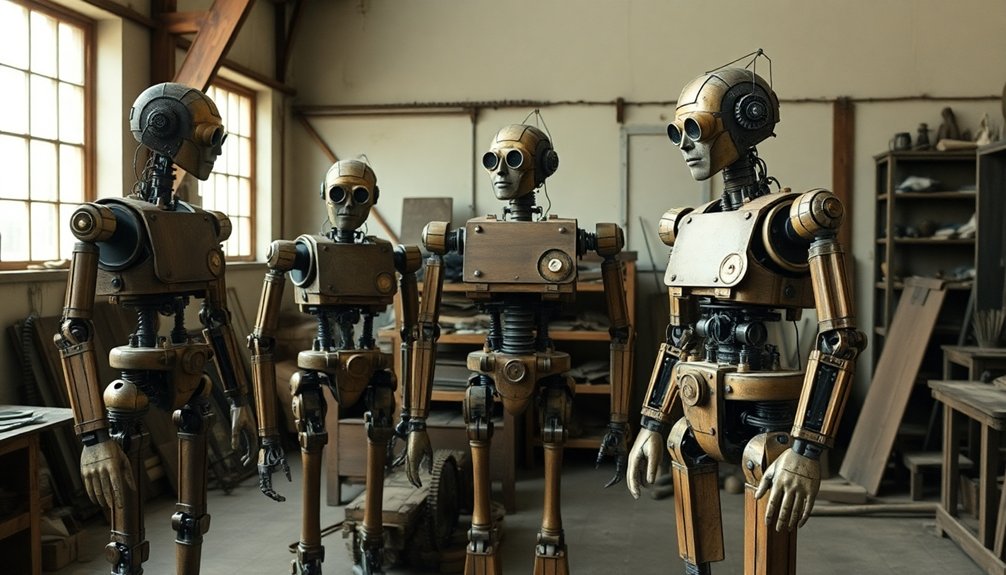
While most people think of robots as a modern marvel, the roots of humanoid machines stretch back to the mechanical wonders of Dresden, where innovative craftsmen were building extraordinary automatons long before computers existed. Early mechanical soldiers represented one of the first breakthroughs in humanoid robotics, with Kaufmann’s 1810 creation demonstrating remarkable engineering potential.
Friedrich Kaufmann wasn’t just an inventor—he was a magician of mechanics, crafting spring-powered robots that could play music and mesmerize audiences. These early machines weren’t just technological experiments; they were performance art.
Using leather, wood, and ingenious notched drums, these mechanical pioneers created robots that moved with surprising grace. Imagine watching a machine play a tiny flute or drum, powered by nothing more than carefully wound springs.
These Dresden inventors didn’t just build robots—they built dreams, turning complex mechanical principles into living, breathing mechanical performers that challenged everything people thought was possible. The legacy of these Middle Eastern automata actually predated Dresden’s mechanical marvels, showing a rich global history of robotic innovation.
From Mechanical Duck to Trumpeting Soldier
The mechanical marvels of Dresden weren’t just quirky one-offs—they were the grandparents of today’s robots, setting the stage for machines that would blow people’s minds. 1810: First Humanoid Robot Created Friedrich Kaufmann’s soldier robot marked a pivotal moment in mechanical engineering, representing the first intentional human-shaped automaton. Humanoid robot technology would eventually evolve to encompass sophisticated systems with advanced sensors and artificial intelligence.
Imagine a mechanical duck that could actually digest food, or a trumpet-playing soldier robot? These weren’t sci-fi fantasies, but real inventions from curious engineers.
Friedrich Kaufmann’s trumpeting humanoid and Jacques de Vaucanson’s digesting duck were more than novelty acts—they were proof that humans could build machines mimicking living things.
Each gear, each intricate movement was a middle finger to the limitations of human imagination.
These early robots weren’t just entertainment; they were technological love letters to what might be possible.
Who’d have thought a mechanical duck could spark an entire robotic revolution?
Early Remote-Controlled Wonders
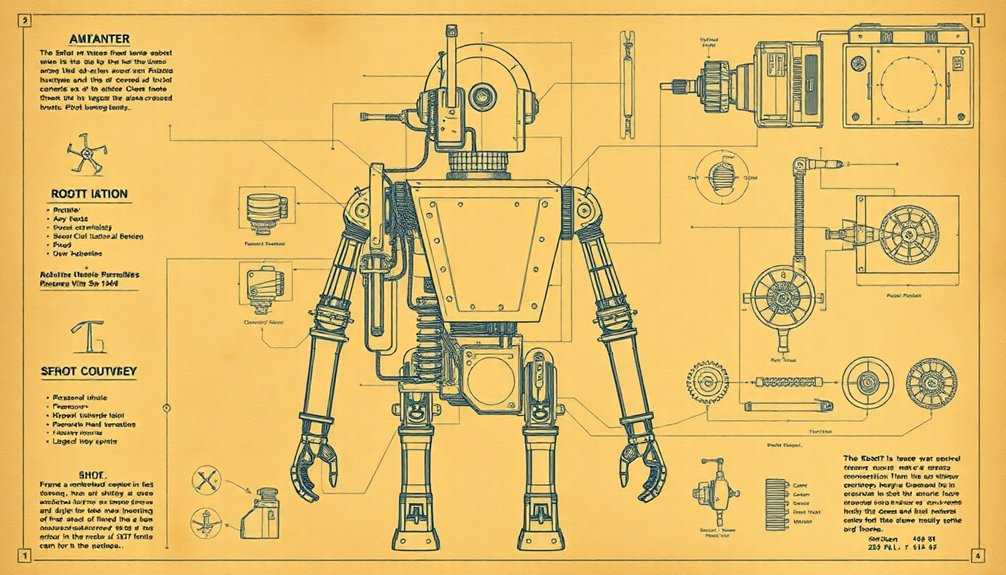
Before robots became the sleek, intelligent machines we recognize today, they were clunky, remote-controlled curiosities that looked like they’d stumbled out of a mad scientist’s workshop.
These early mechanical marvels could do more than just stand around looking awkward:
- Televox controlled appliances with wild electromagnetic magic
- Eric stood and sat on command like a well-trained puppy
- Gakutensoku wrote Japanese characters and changed facial expressions
- Electro walked, spoke, and even smoked at the 1939 World’s Fair
- Kaiser was a radio-controlled robot soldier ready for imaginary battles
These proto-robots weren’t just machines; they were proof that humans could dream up something completely bonkers and actually make it move. The rise of humanoid robot pioneers in the late 1920s marked a fascinating turning point in technological imagination and mechanical innovation.
Imagine explaining to your great-grandparents that someday, machines would go from trumpeting soldiers to AI companions — they’d think you’d lost your mind. In Japan, early robot inventors were pushing the boundaries of mechanical design, creating increasingly complex and interactive machines that captured the public’s imagination.
The First Public Humanoid Performances
Three pivotal moments transformed humanoid robots from wild sci-fi fantasies into real-world spectacles that would make even the most skeptical engineer do a double-take. Da Vinci’s mechanical knight in 1495 started the show, proving robots weren’t just a futuristic dream. The 1928 Model Engineers Society Exhibition dropped jaws with the first public humanoid robot display, while Tony Sale’s George in 1949 proved scrap metal could become something extraordinary. Early mechanical innovators like Ismael al Jazari had already conceived remarkable automated devices centuries before these public demonstrations. Unimate Robotic Arm introduced in 1959 by George Devol and Joseph Engelberger marked a groundbreaking moment in industrial robotics, setting the stage for future humanoid innovations. These technological milestones were driven by remarkable mechanical sensor systems that enabled increasingly sophisticated robotic interactions and movements.
| Year | Event | Significance |
|---|---|---|
| 1495 | Da Vinci’s Knight | First mechanical humanoid concept |
| 1928 | Model Engineers Exhibition | Public robot debut |
| 1949 | George Robot | Scrap metal transformation |
| 1973 | WABOT | Advanced interactive capabilities |
These performances weren’t just technological stunts—they were glimpses into a future where machines could mimic human movements, challenging everything we thought possible.
Technological Marvels of the World’s Fair
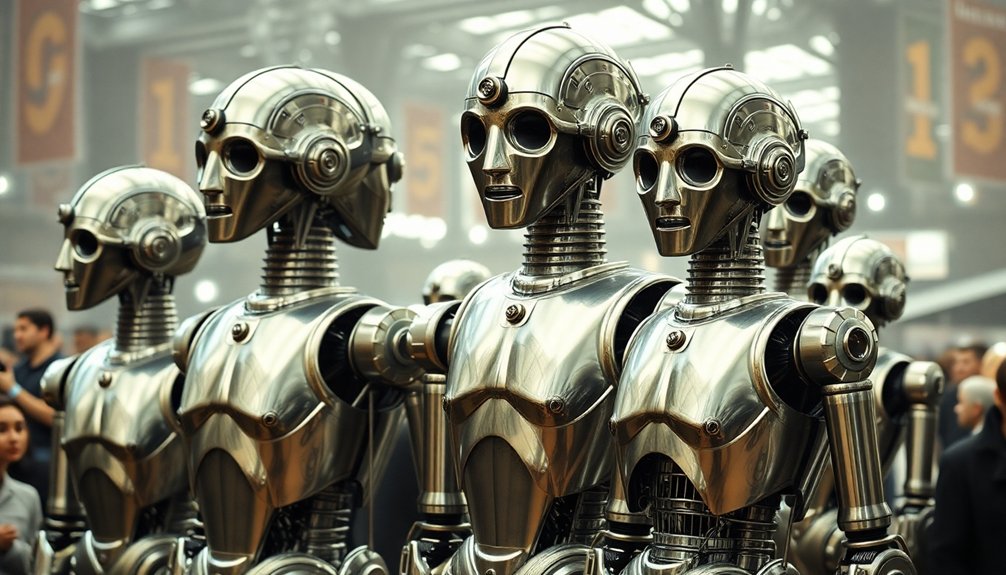
You’ve heard of talking robots, but Elektro at the 1939 New York World’s Fair was the OG mechanical marvel that blew people’s minds, walking and chatting like a metallic magician.
Imagine a seven-foot-tall aluminum giant that could smoke cigarettes, blow up balloons, and speak 700 words – all while looking like something straight out of a sci-fi fever dream.
This wasn’t just a machine; it was a glimpse into a future where robots would transform from clunky curiosities to potential companions, proving that technology could be both mind-boggling and weirdly entertaining. Photoelectric eyes allowed Elektro to distinguish between red and green light, demonstrating an early form of visual perception that hinted at the sophisticated sensory capabilities robots would eventually develop. Westinghouse engineers meticulously crafted Elektro to showcase the potential of robotic technology during an era of rapid technological innovation. Advanced joint motion design enabled Elektro to move with unprecedented smoothness, representing an early breakthrough in robotic locomotion mechanics.
Electro: Speaking Sensation
When the Westinghouse Electric Corporation revealed Elektro at the 1939 New York World’s Fair, it wasn’t just another shiny machine—it was a glimpse into a robotic future that would make sci-fi writers drool.
Standing seven feet tall with a steel skeleton and aluminum skin, Elektro wasn’t your average robot.
Check out its wild capabilities:
- Could speak 700 words using a record player
- Smoked cigarettes (because why not?)
- Walked by voice command
- Blew up balloons on demand
- Distinguished between red and green lights
Imagine the crowd’s reactions when this mechanical marvel strutted around, demonstrating technologies that seemed straight out of a fever dream.
Elektro wasn’t just a machine; it was entertainment, technology, and pure spectacle rolled into one head-turning package.
Who knew robots could be this cool?
Mechanical Wonders Displayed
The 1939 New York World’s Fair wasn’t just another exhibition—it was a technological playground where mechanical marvels came to life and made people’s jaws drop.
Imagine walking into a hall where robots like Elektro towered seven feet tall, weighing 265 pounds, casually smoking cigarettes and blowing up balloons. These weren’t just machines; they were entertainment wrapped in aluminum skin and steel skeletons.
Visitors watched in awe as humanoid robots and mechanical animals performed seemingly impossible tasks.
Sparko the robot dog strutted around, while Elektro’s photoelectric eyes distinguished colors like some kind of mechanical superhero.
Companies competed to showcase the wildest technological innovations, turning the fair into a futuristic carnival that whispered promises of a world where machines could think, move, and maybe even dream. Humanoid robot evolution would later transform these early mechanical prototypes into complex companions capable of emotional interaction and sophisticated processing.
Technological Progress Unveiled
Mechanical marvels like Elektro didn’t just appear out of thin air—they burst onto the scene with the swagger of a technological rock star. This humanoid robot wasn’t just a metal puppet; it was a glimpse into humanity’s robotics-obsessed future. Advanced humanoid robotics like the Unitree H1 series continue to push the boundaries of what mechanical beings can achieve.
Check out what made Elektro a showstopper:
- Voice-activated walking that seemed like pure magic
- Photoelectric “eyes” that could distinguish colors
- A 78-rpm record player for human-like speech
- Ability to smoke cigarettes (because why not?)
- Aluminum and steel construction that screamed “cutting-edge”
Westinghouse didn’t just build a robot; they crafted a cultural phenomenon. Elektro transformed from a mechanical curiosity into a media darling, appearing in films and touring exhibitions.
Who knew a chunk of metal could become a celebrity?
Speaking and Walking: Elektro’s Legacy
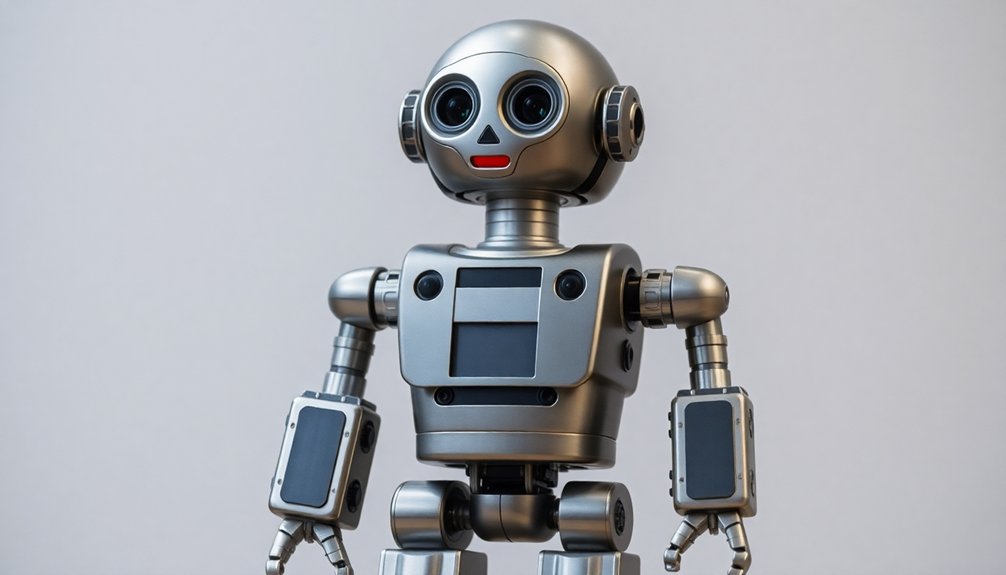
You’ve heard of talking robots, but Elektro was the OG mechanical chatterbox that blew minds at the 1939 World’s Fair.
Imagine a 7-foot aluminum giant cranking out wisecracks through a record player while awkwardly shuffling around on command—this was cutting-edge tech that made people believe the future had arrived.
With its ability to speak 700 words and perform basic gestures, Elektro wasn’t just a machine; it was a glimpse into a world where robots could be more than cold, calculating machines, but almost-human companions ready to change everything.
Electro-Mechanical Voice Synthesis
While most robots today might feel like glorified vacuum cleaners, Elektro was the granddaddy of humanoid voice synthesis that stunned audiences back in the 1930s. His voice tricks were pure mechanical magic:
- Used 78 RPM record players to craft sentences
- Executed commands through photo voltaic cells and telephone relays
- Boasted a surprisingly robust 700-word vocabulary
- Synthesized speech via intricate relay switch systems
- Distinguished between red and green colors like a quirky mechanical genius
Imagine a robot that could talk and “understand” commands using nothing more than spinning records and electrical switches.
Elektro wasn’t just a machine; he was a technological rock star who transformed how people imagined interactive machines. His electro-mechanical voice synthesis wasn’t just innovative—it was the primitive blueprint that whispered promises of our AI-driven future.
World’s Fair Spectacle
When the 1939 New York World’s Fair rolled into town, Elektro wasn’t just another exhibit—he was a mechanical rockstar that made people stop and stare. Standing seven feet tall in the Westinghouse Pavilion, this aluminum-skinned wonder captured imaginations with his futuristic moves. You could watch him smoke, count, and respond to voice commands—all mind-blowing stuff for the “World of Tomorrow” crowd.
| Robot Feature | Cool Factor | Crowd Reaction |
|---|---|---|
| Voice Commands | High | Amazed |
| Smoking Trick | Epic | Stunned |
| Counting Fingers | Clever | Impressed |
Accompanied by his robot dog Sparko, Elektro wasn’t just technology—he was performance art. He proved machines could be more than cold, calculating devices. They could be entertaining, surprising, and just a little bit human. Who wouldn’t want to see that?
Robotic Movement Breakthrough
Since the days of Elektro’s clunky aluminum charm, humanoid robots have transformed from circus curiosities into something that might actually change how we live and work.
These mechanical pioneers blazed trails in robotic movement through:
- Breaking mechanical limitations with steel gear cams
- Demonstrating basic walking and interaction capabilities
- Speaking via 78-rpm record players (how’s that for vintage tech?)
- Performing quirky tasks like smoking and blowing balloons
- Inspiring future generations of more sophisticated robots
Early humanoid robots weren’t just technological experiments—they were audacious proof that machines could mimic human movement.
Engineers wrestled with complex mechanical challenges, pushing boundaries of what seemed possible.
Each jerky step, each awkward arm movement was a demonstration of human ingenuity.
Who could’ve predicted that these early, almost comical attempts would lay groundwork for robots that might one day walk alongside us, work with us, maybe even understand us?
Japan’s First Steps in Humanoid Design
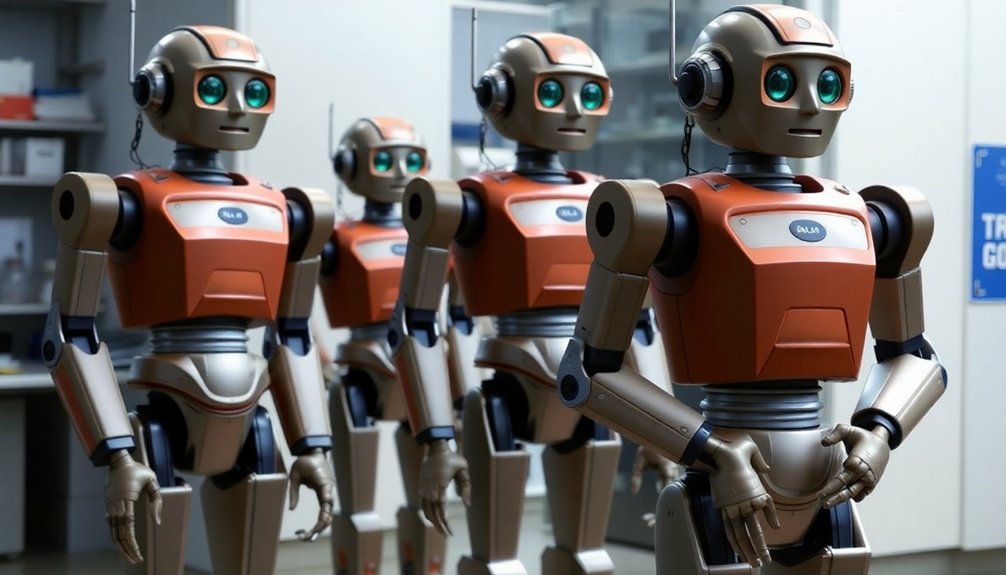
Japan’s robotics journey began with a peculiar dream that robots could be more than just mechanical servants.
Enter Gakutensoku, the East’s first robot, crafted in the late 1920s by Makoto Nishimura. Unlike the industrial automatons you’d expect, this robot celebrated humanity and nature. Wild, right? It toured Japan and even hit the international stage, vanishing mysteriously after its exhibitions.
Meet Gakutensoku: Japan’s 1920s robot pioneer celebrating humanity, nature, and mystery beyond industrial machinery.
Then came WABOT-1 in 1973, Waseda University’s groundbreaking humanoid. This wasn’t just another machine—it could see, converse, and move like a human.
Imagine a robot that wasn’t just a tool, but a potential companion. With advanced limb control and vision systems, WABOT-1 wasn’t just pushing technological boundaries; it was rewriting our entire understanding of what robots could be.
Breaking Barriers: The First Balanced Robot
If balance seemed like an impossible dream for early roboticists, BHR-1 would shatter those limitations forever. This Chinese marvel transformed robotic mobility from clunky sci-fi fantasy into reality.
Want to know how? Check out these game-changing features:
- Untethered bipedal walking that didn’t rely on external support
- 28 degrees of freedom allowing complex whole-body movements
- Dynamic walking speeds up to 2 km/h
- Advanced sensor integration for real-time stability
- Breakthrough design proving robots could literally stand on their own
Imagine the jaw-dropping moment when engineers first watched BHR-1 navigate without falling over. This wasn’t just a machine; it was a declaration that humanoid robots could balance, move, and potentially challenge our understanding of mechanical movement.
Skeptical? The proof was literally walking right in front of them.
Global Innovations in Human-Like Machines
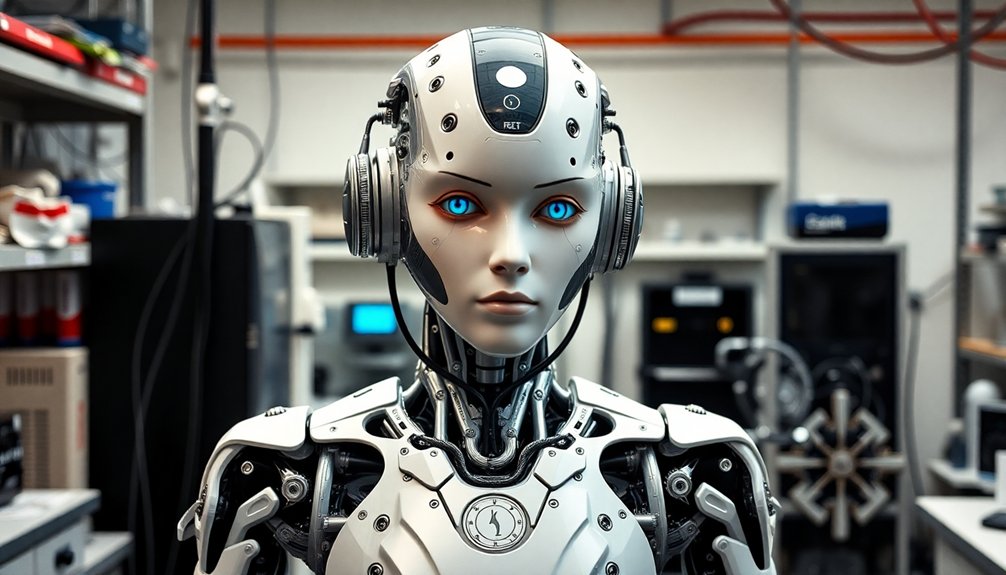
You might think robots are just cold, metallic machines churned out by nerdy engineers, but international innovators are proving that human-like machines can reflect cultural creativity and unique design perspectives.
From Japan’s precise digital anthropomorphic robots to China’s cutting-edge social machines like Jiajia, different regions are bringing their own technological DNA to humanoid development.
Imagine robots that aren’t just functional tools, but intricate expressions of human imagination – mechanical mirrors that reveal as much about their creators as they do about potential technological futures.
International Robotic Pioneers
While mechanical marvels have fascinated humans for centuries, the global quest to create human-like machines took a quantum leap with pioneering innovations from unexpected corners of the world.
These robot trailblazers didn’t just dream — they built wild contraptions that pushed technological boundaries:
- Friedrich Kaufmann crafted a trumpet-playing soldier robot in 1810, proving machines could mimic human actions.
- Ichiro Kato developed WABOT, the first dynamically balanced humanoid at Waseda University.
- Jacques de Vaucanson’s mechanical duck in the Renaissance demonstrated complex mechanical movement.
- W. H. Richards introduced Eric, a robot sensation at the 1928 Model Engineers Society exhibition.
- Hisashige Tanaka, nicknamed “Japan’s Edison,” created intricate mechanical toys that hinted at future robotic potential.
These pioneers didn’t just build robots — they rewrote what humans thought was possible.
Cultural Machine Design
Some might argue that humanoid robots are just fancy metal dolls, but the truth is far more fascinating.
These mechanical marvels aren’t just cold, calculating machines—they’re cultural artifacts that reflect human imagination.
Think about it: from Leonardo da Vinci’s mechanical knight to Hisashige Tanaka’s intricate Japanese automata, each robot tells a story about the era that birthed it.
Your favorite sci-fi movie? It’s probably drawing inspiration from decades of robotic design evolution.
Cultural influences shape how we dream up these human-like machines, turning them from mere technical experiments into art forms that challenge our understanding of intelligence and creativity.
Whether it’s a trumpet-playing robot soldier or a sleek modern android, these designs are more than just technology—they’re mirrors reflecting our collective human ambition.
Transforming From Mechanical to Intelligent Robots
Since the dawn of mechanized motion, humanoid robots have evolved from clunky, predictable machines into something far more fascinating: thinking, adapting digital companions.
They’ve transformed from mere entertainment novelties to potential partners in complex human environments. How’d they make this leap? Check out the key shifts:
- Computing power turned robots from mechanical puppets into dynamic learners
- Sensor integration gave machines “eyes” and “ears” to understand surroundings
- Machine learning enabled adaptive responses instead of pre-programmed behaviors
- AI algorithms help robots interpret context and make nuanced decisions
- Advanced mobility lets robots navigate real-world spaces like humans do
Imagine robots that aren’t just tools, but intelligent collaborators who can read a room, solve problems, and maybe even crack a joke.
The future’s looking seriously cool.
The Rise of Agile and Responsive Humanoid Designs
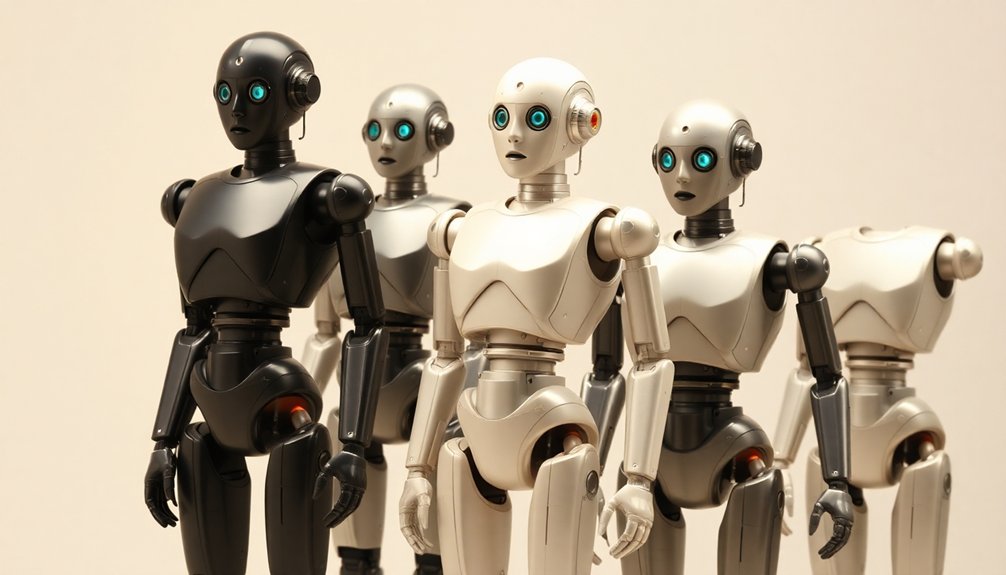
The mechanical puppets of yesteryear have grown some serious muscles.
Today’s humanoid robots aren’t just stiff automatons—they’re learning, adapting machines with killer moves and lightning-fast reflexes. Imagine robots that can dodge, weave, and respond faster than you can blink.
Advanced sensors and AI have transformed these metal companions from clunky curiosities into agile performers. They’re not just following pre-programmed scripts; they’re reading the room, adjusting on the fly, and working shoulder-to-shoulder with humans.
Robots are intelligence in motion, dynamically sensing, adapting, and collaborating with humans in real time.
Robust actuation systems and cutting-edge materials mean these robots can now leap, pivot, and interact with a fluidity that would make their robotic ancestors jaw-drop.
Who knew machines could get this cool?
People Also Ask
Were the First Humanoid Robots Actually Functional or Just Novelty Items?
You’ll find early humanoid robots were primarily novelty items, designed to entertain rather than perform practical tasks. They could move and mimic human actions, but weren’t genuinely functional beyond creating public fascination.
How Expensive Were Early Humanoid Robots Compared to Other Technologies?
You’d find early humanoid robots were considerably more expensive than contemporary technologies, with costs driven by complex mechanical systems and limited digital capabilities that made them more of a technological curiosity than practical devices.
Did the First Robots Communicate or Only Perform Basic Mechanical Movements?
“Jack of all trades, master of none.” Early robots weren’t great communicators; they’d mostly perform basic mechanical movements. You’d find they could walk, gesture, and sometimes speak through pre-recorded messages, but true interaction was limited.
Who Funded the Initial Research and Development of Early Humanoid Robots?
You’ll find early humanoid robot research was primarily funded by companies like Westinghouse Electric Corporation, alongside pioneering universities such as Waseda in Japan and government agencies like DARPA supporting technological innovation.
Could the First Humanoid Robots Learn or Adapt to Different Tasks?
You couldn’t learn, and you couldn’t adapt. Early humanoid robots relied on pre-programmed routines, lacking AI integration and sophisticated control systems to dynamically respond to changing tasks or environmental challenges.
The Bottom Line
From clunky mechanical ducks to trumpeting soldiers, you’ve just witnessed humanity’s wild journey into robotics. These early humanoids weren’t just machines—they were dreams made of gears and imagination. Who knew those awkward first steps would lead to today’s mind-blowing robotic innovations? You’re standing at the edge of a technological revolution that’ll make those old mechanical pioneers look like wind-up toys. Buckle up—the future of robotics is going to be one incredible ride.
References
- https://kawasakirobotics.com/asia-oceania/blog/2101-01/
- https://www.science.org/doi/10.1126/scirobotics.aar4043
- https://www.howwegettonext.com/a-history-of-humanoids/
- https://www.roboticsacademy.com.au/history-of-robots/
- https://www.datategy.net/2024/04/02/the-rise-of-humanoid-robots-progress-and-challenges/
- https://flashbak.com/1810-friedrich-kauffman-of-dresdens-first-robot-in-history-5614/
- https://davidpapp.com/2023/01/31/the-humanoid-robots-market-what-to-expect/
- https://en.wikipedia.org/wiki/Humanoid_robot
- https://www.pinterest.com/pin/pa5847324-1–427630927122328419/
- http://blog.salvius.org/2014/01/a-history-of-robotics-vaucansons-duck.html
